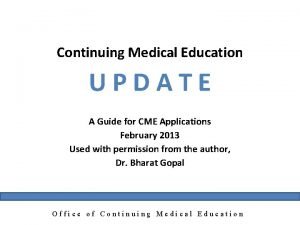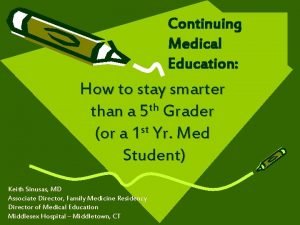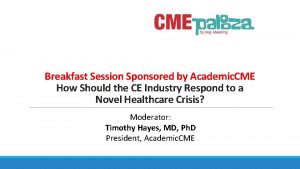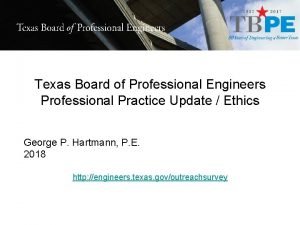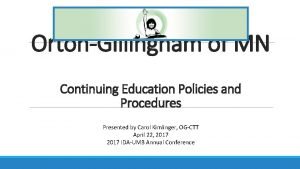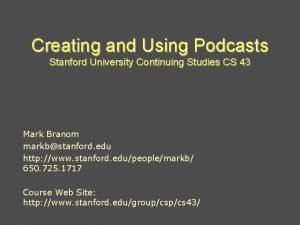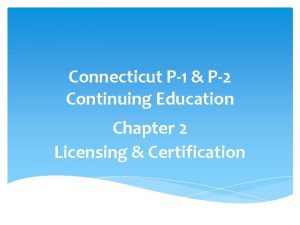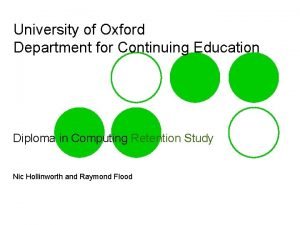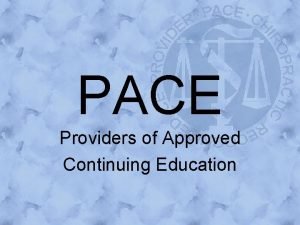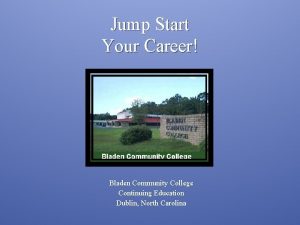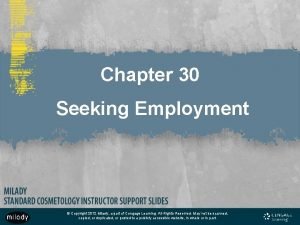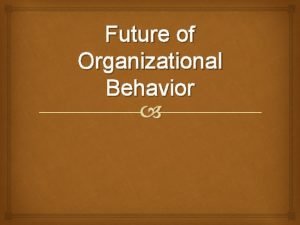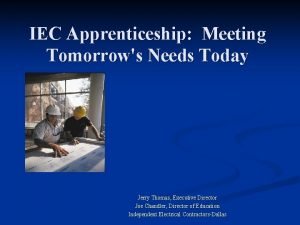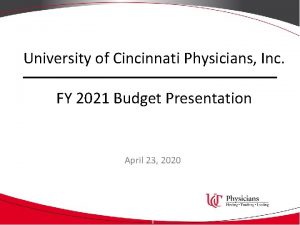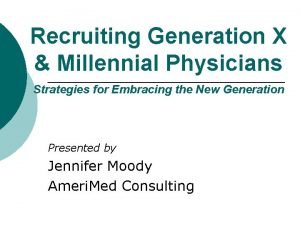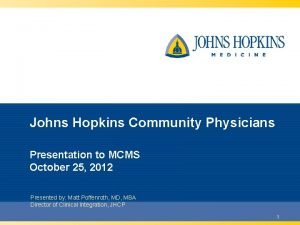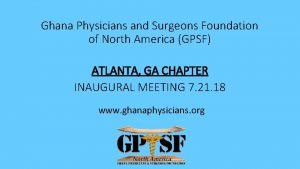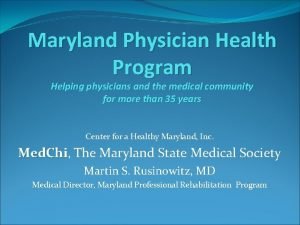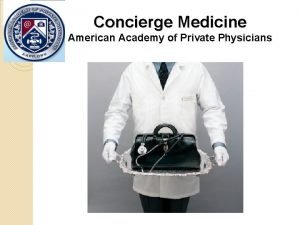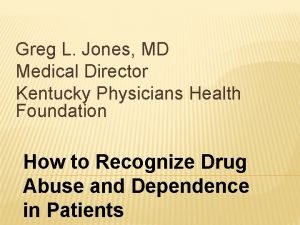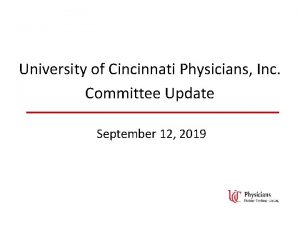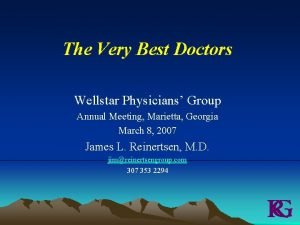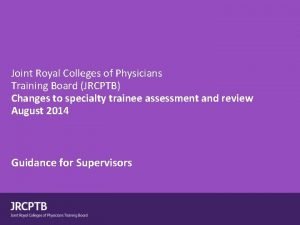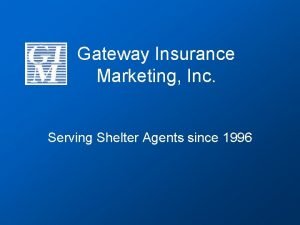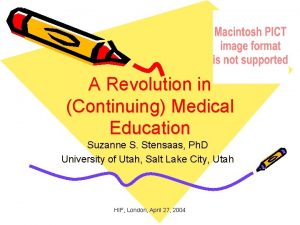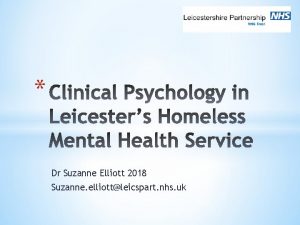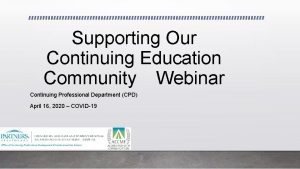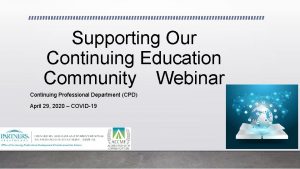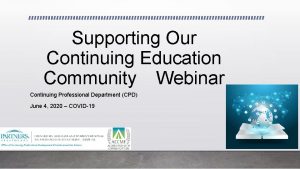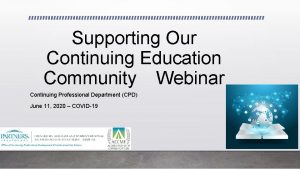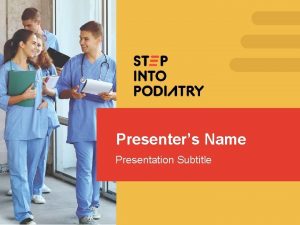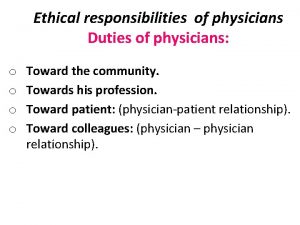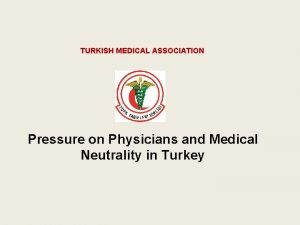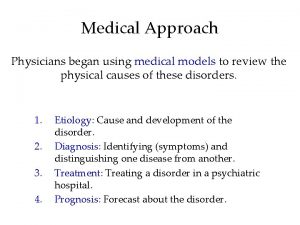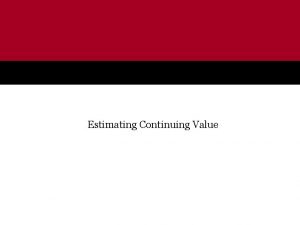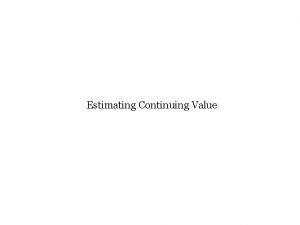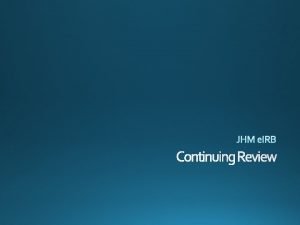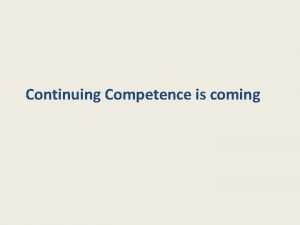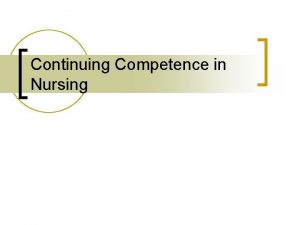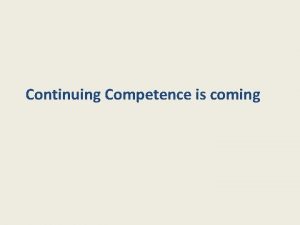Providing Effective Continuing Medical Education for Physicians Suzanne


































- Slides: 34

Providing Effective Continuing Medical Education for Physicians Suzanne Ziemnik, MEd Director, Division of CME American Academy of Pediatrics

“Continuing medical education is a distinct and definable activity that supports the professional development of physicians and leads to improved patient outcomes. It encompasses all of the learning experiences that physicians engage in with the conscious intent of regularly and continually improving their performance of professional duties and responsibilities. Essential to the continuum of medical education, CME shapes the growth and development of physicians in their full range of duties and responsibilities. ” (Academic Medicine, 2000, 75: 1167 -1172)

“In what is typically an intensive 2 - or 3 - day short course, (instructors lecture and lecture) fairly large groups of…professional people who sit for long hours in an audiovisual twilight, making never-to-be-read notes at rows of narrow tables covered with green baize and appointed with fat binders and sweating pitchers of ice water. ” Philip Nowlen, 1988

Does CME Work? Studies of the effectiveness of CME measured against physician performance and health care outcomes

EFFECTIVENESS OF INTERVENTIONS by Type of Intervention Positive outcomes Negative/inconclusive outcomes Number of interventions demonstrating positive or negative/ inconclusive change (presented by Dave Davis, MD to the Specialty Society SIG at the Alliance for CME Annual Conference January, 2000)

Findings Didactic interventions fail to change physician performance or health care outcomes Interactive CME is more effective in changing physician performance or health care outcome Sequenced CME interventions appear to have more impact Addition of "enabling methods" which may facilitate adapting to changes in the practice site are effective Multiple or longitudinal interventions demonstrated positive outcomes on physician performance (and in some cases on health care outcomes) as compared to single interventions No relationship between group size and positive outcomes

Implications of the Findings Interventions to improve professional performance are complex There are no “magic bullets” to change practice in all circumstances and settings (Oxman, 1995) Multi-faceted interventions targeting different barriers to change are more likely to be effective than single interventions (Davis, 1995; Davis, 1999)

Role and Value of Traditional CME Reaffirming and/or increasing knowledge Validating current practice behavior Changing attitudes Providing multiple messages

"Optimal CME is highly self-directed, with content, learning methods, and learning resources selected specifically for the purpose of improving the knowledge, skills, and attitudes that physicians require in their daily professional lives that lead to improved patient outcomes. ” (Academic Medicine, 2000, 75: 1167 -1172)

Recommendations for Effective CME Highly self-directed Incorporates interactive learning formats Includes practice enabling and reinforcing strategies Accessible within physicians' practice or work settings Physicians recognize knowledge, skills and attitudes to maintain competence (AAMC Statement on Lifelong Professional Development and Maintenance of Competence, 2000)

More Recommendations for Effective CME Accommodates the different styles of learning that will be seen within a community of learners Relates directly to the maintenance of competence of the practitioner Link to evidence-based medicine whenever possible Learner-centered Active rather than passive

More Recommendations for Effective CME (cont’d) Link to improving physicians' practice behaviors and patient outcomes Based on individual's real needs (based on objective methods) and perceived needs Engaging Reinforcing Relevant to clinical practice Point-of-Care CME

Eight Principles to Guide CME planning and program development should be based on needs assessment, including outcomes data. Goal of CME should include the development of skills necessary for lifelong learning, the exercise of clinical reasoning, an understanding of the decision making process, and specific content acquisition. Multiple goals of CME should be reinforced by the appropriate choice of learning methods Incorporation of new instructional technologies for CME should be based on their intrinsic strengths as learning tools after thorough evaluation

Eight Principles to Guide CME (cont’d) Faculty development is important within CME and should include exposure to new learning methods (theory and application), enabling faculty to translate their content expertise into formats more appropriate to learners' needs. Educational activities should be supportive of and coordinated with the transition to evidence-based medicine. Professional and, whenever possible, interdisciplinary interaction should be given priority in CME programming. Outcomes-based measures of CME effectiveness and research should be introduced into the determinants of physicians' practice behaviors. ( Academic Medicine, Vol. 74, No 12/December 1999)

Self-directed Learning "Physicians must understand control their own learning experiences with access to professional activities that are appropriate for the practice environment. " (Bennet, et al) "The efficiency and effectiveness of learning in the workplace is related to a physician's ability to select the right problems to solve, frame the problem in terms of a question or problem statement, successfully obtain and appraise the information retrieved, and develop a plan to integrate the learning into practice. " (Campbell, et al)

Recognition of Stages of the Learning Process Determining if the content of the CME program is relevant Using the CME event as one of several resources selected for learning Already implementing changes in practice and seeking assurance of doing the "right thing"

Assessment of Outcomes in Continuing Education LEVELS 1 Op Pe inion Att rcep s, en tio da ns, nc e. D ata 2 Co (kn mpe att owl tenc Pr itude edge e ofe s , ss ) of skil ion H ls, als eal th 3 4 He Pa a l Pe th Ca tient rfo Pr re /He rm ofe Ou alt an ss tco h ce ion me al s (Adapted from Dixon, J. Eval. & the Health Prof. 1977 and presented by Davis to the Specialty Society SIG at the Alliance for CME Annual Conference, January, 2000)

Barriers to Measuring the Effectiveness of Level 3 and Level 4 Educational Interventions Ability to demonstrate a causal relationship between the educational intervention and the observed effect Nature of specialty society CME targeted to a national audience Financial Time

Core Competencies for CME Educators Guide physician learners as they continually assess their own ongoing learning needs, and identify opportunities and resources to meet those needs in order to enhance performance and promote lifelong learning skills Study the role of continuing professional development to enhance physicians' knowledge, performance, and health care outcomes Design a CME list of effective educational strategies that uses research findings about how physicians learn and enact changes in their professional behaviors, and that addresses the variety of learning styles and learning needs

Core Competencies for CME Educators (cont’d) Cooperate with CME educators and others throughout the continuum of medical education to maximize the ability of CME to meet the varied learning needs of physicians and health care systems Ensure that systems for measuring improvement of physician performance link CME to health care outcomes Enhance the professional development of CME educators, including their understanding and use of theory and research to provide effective support for appropriate changes in physicians' knowledge, performance, and health care outcomes (Academic Medicine, 2000, 75: 1167 -1172)

American Academy of Pediatrics Continuing Medical Education Mission Statement The continuing medical education program of the American Academy of Pediatrics seeks to develop, maintain and/or increase the knowledge, skills and professional performance of primary care pediatricians, pediatric medical subspecialists, pediatric surgical specialists, and other pediatric health professionals by providing them with the highest quality, most relevant and accessible education experiences possible…. The ultimate goal of the overall CME program is for participants to better identify their personal educational needs and be able to design appropriate self-directed learning plans to meet those needs. Adopted May 15, 1998

AAP CME Program Live CME Activities – Directly Sponsored – Jointly Sponsored Enduring Materials – Internet CME – Print CME – Other Multimedia CME

AAP Strategies for Educating Physicians “Traditional” models/approaches transitioning to interactive, learner-centered formats Innovations

Innovations Pedialink: AAP CME Home e. QIPP (Education in Quality Improvement for Pediatric Practice) Super. CME

Pedia. Link. org™ A powerful online learning system designed to assist pediatricians to direct, focus, and manage their CME/CPD.

Pedia. Link. org™ One stop spot for point-of-practice information and professional development Tracks and provides feedback on the quality of the individual pediatrician’s learning cycle Highly individualized and dynamic tool for lifelong professional development

e. QIPP Interactive online educational system designed to help pediatric health care professionals to: – learn about quality improvement strategies – collect and analyze practice data over time – document improved quality of care

e. QIPP Incorporates interactive, topic-focused CME Content derived from evidence-based guidelines and best practices Self-assessment based on real time chart audit and feedback with opportunity for peer benchmarking

e. QIPP Features – facilitated online discussions – practice enablers, tools and templates – reminder systems – patient satisfaction surveys – supporting resource materials

Super. CME Features Actors perform "real life" cultural communication issues encountered in the office Heart Sounds Workshop featuring new state-of-the-art advanced digital heart sound system coupled with infrared transmission and digital projection "I'll Take Adolescent Health for a Thousand, Alex" E-mail networking to connect online with fellow attendees before and after Super. CME "Guaranteed your questions are addressed by the professor - When you register early!"

The Future "With the realization that lifelong learning is more than attending conferences, the potential for greatly expanding effective CME has never been more encouraging. " (Manning)

The Future (cont’d) "The social attraction of colleagues and the desire to interact personally with medical experts will ensure the survival of live conferences. Teleconferencing will become more practical as costs decline through the use of the Internet. Medical journals, print or electronic, will remain the dominant source of new research and clinical information. " (Manning)

References Abrahamson S, et al: Continuing medical education for life: eight principles. Acad Med 1999 Dec; 74(12): 1288 -94. Bennett, NL, Davis DA, et al: Continuing Medical Education: A New Vision of the Professional Development of Physicians. Academic Medicine (2000) 75: 1167 -1172. Davis DA, Fox RD: The Physician as Learner: Linking Research to Practice. Chicago: American Medical Association, 1994, pp 310; 245. Davis DA, Thomson MA, Oxman AD, et al: Changing physician performance: A systematic review of the effect of continuing medical education strategies. JAMA 1995: 274: 700 -705.

References (cont’d) Davis DA, Thomson MA, Freemantle N, et al: Impact of formal continuing medical education: Do conferences, workshops, rounds and other traditional continuing education activities change physicians behavior or health care outcomes? JAMA 1999; 282: 867 -874. Fox RD, Mazmanian PE, Putnam RW: Changing and Learning in the Lives of Physicians. New York: Praeger Publishers, 1989. Manning Phil R, De. Bakey L: Continuing Medical Education: The Paradigm Is Changing. The Journal of Continuing Education in the Health Professions, 2001, Volume 21, pp 46 -54. Oxman, AD, Thomason MA, Davis DA, et al: No magic bullets: A systematic review of 102 trials of interventions to improve professional practice. Can Med Assoc J 1995; 15: 153.
 Continuing medical education
Continuing medical education American association of continuing medical education
American association of continuing medical education Continuing medical education
Continuing medical education San diego continuing education north city campus
San diego continuing education north city campus Tbpe ethics exam answers
Tbpe ethics exam answers Imslec certification
Imslec certification Stanford continuing studies certificate
Stanford continuing studies certificate Kylene perras
Kylene perras P2 plumbing license
P2 plumbing license Uq eap
Uq eap Nj institute for continuing legal education
Nj institute for continuing legal education Professional engineer georgia
Professional engineer georgia Life long education artinya
Life long education artinya Oxford continuing education
Oxford continuing education Dlgf(dlgf)continuing education/webinars
Dlgf(dlgf)continuing education/webinars Rewley house continuing education library
Rewley house continuing education library Fclb
Fclb Bladen community college online classes
Bladen community college online classes What habits and characteristics do test-wise students
What habits and characteristics do test-wise students Importance of continuing education
Importance of continuing education Iec dallas continuing education
Iec dallas continuing education Aea continuing education
Aea continuing education University of cincinnati physicians inc
University of cincinnati physicians inc Recruiting millennial physicians
Recruiting millennial physicians Johns hopkins community physicians
Johns hopkins community physicians Ghana physicians and surgeons foundation
Ghana physicians and surgeons foundation Maryland physician health program
Maryland physician health program The concierge academy
The concierge academy Greg jones md
Greg jones md University of cincinnati physicians inc
University of cincinnati physicians inc Primary care physician wellstar
Primary care physician wellstar Jrcptb dops
Jrcptb dops Jrcptb patient survey
Jrcptb patient survey Physicians mutual gateway
Physicians mutual gateway Physicians in north central washington
Physicians in north central washington
